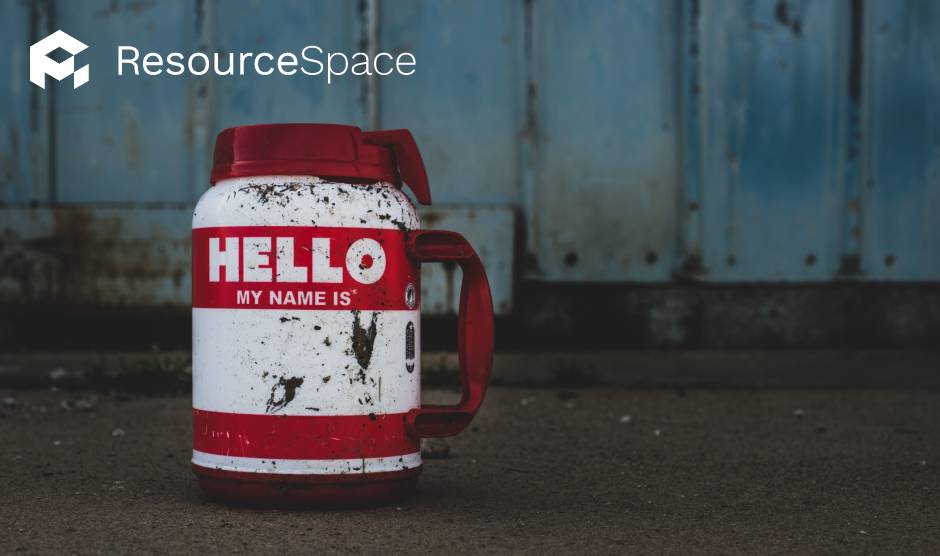
The team at ResourceSpace have been a joy to work with, helping us manage what could've been a really difficult transition every step of the way.
Blog
29th July 2022

Do you ever figure out what image you want to use for a piece of marketing or sales collateral, search for it in your file storage solution and... nothing?
The file isn't in the folder it should be, and all of your searches based on what you think it's called don't turn up anything.
If you're using a file storage solution like Google Drive, Dropbox or Microsoft SharePoint, you're probably familiar with this problem. In fact, if you're using SharePoint specifically, we've got a whitepaper you might be interested in.
If you want to reduce the incidents of lost assets within your file storage solution, or just save yourself some time, you need to implement a strict set of file naming conventions.
A file naming convention is a standardised way to name files so they are easy to find, sort, and identify at a glance. For example, instead of final_version2.docx, you might use 20240729_Marketing_Plan_v2_Smith.docx.
Your file names should be as short as possible while retaining enough meaning to make them identifiable from similar assets. It's a tricky, but vital, balance to strike.
Using meaningful abbreviations is a good tip to achieve this. For example, if the file is a blog featured image, you could use the abbreviation 'feat'.
Using consistent and relevant file name elements will also help with keeping them short and meaningful. Using too many could cause some technical issues (for example, the maximum file path is 259 characters in Windows), while too few will make it hard to distinguish between files.
The order of the elements in the file name should relate to the importance of that information, while the order should also be consistent between files.
One example might be:
'[DATE]_[DESCRIPTION]_[VERSION NUMBER]_[AUTHOR]'
How might this look?
'20222707_SalesDeckPres_v3_SSmith'
Special characters in your file names as these are sometimes defined functions in operating systems, and cause issues when saving and searching for files.
Special characters to avoid include but are not limited to:
* : \ / < > | " ? [ ] ; = + & £ $
Add a clear version number or status to each filename to avoid confusion over which file is the most recent.
Example: AnnualReport_v2 or PolicyDoc_DRAFT
This helps avoid multiple people editing outdated versions or overwriting the latest file.
Including a date makes it easy to track the most recent versions. Use a consistent structure like YYYYMMDD to keep files sorted chronologically and avoid ambiguity.
For example: MeetingNotes_20250801.docx not MeetingNotes_1Aug25.docx
Break up the filename using hyphens (-) or underscores (_) to improve readability. Avoid running all the words together or using inconsistent formatting.
For example:
Good: ClientA_Invoice_20250801.pdf
Bad: ClientAInvoiceAug1.pdf
To bring the above tips to life, here are a few practical examples showing how files can look with and without a clear naming convention:
| Example File | Without a Convention | With a Convention |
|---|---|---|
| Image file | image1.jpg |
20240729_Event_Poster_v1.jpg |
| Document | doc_final_v2.docx |
20240615_ProjectReport_v2_Jones.docx |
| Presentation | final.pptx |
20240701_ClientPitch_v3_SalesTeam.pptx |
| Video file | vid.MP4 |
20240630_ProductDemo_V1_HRTeam.mp4 |
These improvements make each file easier to understand at a glance, saving time, avoiding duplicates, and keeping things consistent across teams and storage systems.
While best practices are useful, the most effective file naming conventions are those tailored to your team’s needs. Here are a few tips to help you establish one that works:
Unfortunately, even when you’ve spent time creating detailed documentation around your file naming convention, assets will still sometimes go missing, whether that’s because the naming convention hasn’t been followed or the file has been moved to a different drive.
You might not even want to find a specific file, but see a selection of files that match a specific theme, for example if you want to browse different images for some content you’re creating.
This is why Digital Asset Management (DAM) is so much more effective than traditional file storage.
That’s because a DAM like ResourceSpace is built on metadata. When you use metadata as the primary method of organising digital assets, those assets can be classified in a number of different ways. Need to find an image of a family for a blog post or web page, but don’t have a specific image in mind? Simply searching for ‘family’ will return all images tagged with the metadata ‘family’. You don’t need to know the name of the file you’re looking for, you just need to search for related categories.
ResourceSpace allows for fixed metadata fields so you can control the metadata inputs, including through dropdown lists, radio buttons or checkboxes, as well as AI tagging. AI automated tagging will recognise objects, terms, faces and places present in an image and prompt appropriate keywords for the user to choose from.
This doesn’t mean file naming conventions aren’t still important, don’t start uploading files with nonsensical names or neglecting folder logical structure, but it does mean more searching for the perfect digital asset, whether you know what that’s going to be or not, is so much easier.
In short, ResourceSpace’s file naming best practices, when combined with powerful metadata and version control, make your DAM cleaner, faster and more reliable.
Ready to put this into action? Speak with our expert team to see how ResourceSpace can help you organise and retrieve assets more efficiently.
#BestPractice
#FileNamingConventions
#ResourceSpaceTips
#FileStorage
#GoogleDrive
#Dropbox
#SharePoint
#Marketing
#Sales
#DocumentManagement
#DataManagement
#Training